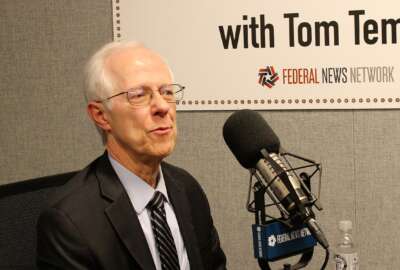Government shutdown or not, it’s exhausting
Former federal executives say taking care of employees' emotional highs and lows during the preparation for a government shutdown is just as important as the...
As of Sunday, 1.5 million federal civilian employees and 2 million servicemembers got the news they were hoping for: House and Senate leaders reached a deal to keep the government open.
The last several weeks of anxiety, hopefully, melted away among federal employees and contractors as President Joe Biden signed the 45-day continuing resolution ensuring the missions continue and people get paid.
The emotional toll of preparing for a shutdown, of potentially being furloughed, of your routine being interrupted and the spending all the time and energy to close down the mission you love — or at least like on most days — can be just as taxing.
And this physical and emotional toll of preparing for a shutdown is a huge test for any public or private sector manager and leader.
“This is incredibly stressful for everyone,” said Emily Murphy, the former administrator of the General Services Administration during the 2018-2019 35-day government shutdown. “Shutdowns are depressing for agencies, for employees and contractors.”
And with the CR only running only to Nov. 17, employees likely will be right back in this anxiety filled environment in another month.
Murphy and others who have lived through the recent shutdown during the Trump administration and the 2013 lapse of appropriations during the Obama administration say senior executives, political appointees and other leaders must focus as much on the human aspects of a shutdown as they do on the operational side.
Maria Roat, the former federal deputy chief information officer and CIO at the Small Business Administration, said managers have to recognize the significant cost to morale of all employees and contractors as the build up to a shutdown ramps up.
“We are all human and regardless of communications, there is anxiety because of the unknown duration of a shutdown. I was up-front about the impacts, shared what I knew and answered questions openly and honestly throughout the entire shutdown lifecycle,” she said. “Federal employees are some of the most hardworking people I know. They are especially dedicated to the government’s mission of serving the public. It is ultimately the public that is the most impacted and hurt the most.”
Those up-front conversations, hopefully, have been ongoing for the better part of September. The hardest ones revolve around who is “excepted” and who is not, meaning those workers would be furloughed.
Striking the right tone with employees
Murphy emphasized managers need to make it clear the decision to furlough an employee has nothing to do with real value of their job to the agency.
“It all comes down to obscure funding rules. It is not based on the self-worth of the employee. You have to make sure all of them feel valued,” she said.
The Defense Department struck this tone in their lapse in appropriation guidance issued Friday.
“Importantly, the categorization of employees and whether or not someone is furloughed are not a reflection on the quality of an employee’s work, nor of his or her importance to the department. It is merely a reflection of the legal requirements under which we must operate should a lapse in appropriations occur,” wrote Kathleen Hicks, the deputy secretary of Defense.
While there isn’t any specific data on what it costs to prepare for a shutdown, the Senate Homeland Security and Governmental Affairs Committee looked at several factors in its 2019 report analyzing the last three shutdowns: one in 2013, and then two in 2018, the second of which lasted into January 2019.
Committee staff received data from 26 agencies about the costs of a shutdown, including on the administrative side. It defined administrative costs as “the estimated cumulative amount of costs incurred as a result of implementing and completing shutdown activities, monitoring the status of the shutdown, and reopening and restarting normal agency operations once the funding gap was resolved.”
Shutdown planning costs are high
While not every agency provided this estimate, the committee found “at least $338 million in other costs associated with the shutdowns, including extra administrative work, lost revenue and late fees on interest payments.”
For example, the Consumer Product Safety Commission estimated the 35-day shutdown from 2018 to 2019 cost $995,000 in administrative costs
Another example, NASA, which planned to furlough about 17,000 employees if a shutdown had happened, said the most recent closure added up to over $27 million in administrative costs.
Jim Williams, a former GSA administrator and long-time federal executive, said employees are looking for leaders to not just lead but provide words of encouragement, support and even advice before, during and especially after a shutdown.
He said the message has to be around recognizing the shutdown is bad, but “we have to be ready to come back to work and need to know what’s important and what are the priorities. There are people out there who count on us to do this mission. We’ve got to minimize the impacts of this as much as we can, and show the American people that we are worthy of trust and respect of the job we do.”
The continued erosion of trust in government is another big concern for federal employees. A Federal News Network online poll last week found 16% of the respondents said their biggest concern was the further impact to trust in government. While not getting a pay check and the impact of the agency’s mission were considered bigger concerns for agencies, employees are keenly aware of what shutdowns do to citizens and businesses.
Greg Giddens, a former acquisition executive at the Department of Veterans Affairs, said leaders must be able to counter any feelings of losing confidence in the “system.”
“The vast majority of federal employees work hard with a sense of passion connected to the mission of their agency,” he said. “They then see that the hard work and sacrifices they make does not seem to apply to the ‘system’ that should be enabling them to deliver to the nation’s citizens. It becomes a huge morale factor for the workforce.”
45 days until next possible shutdown
Several federal executives, who spoke on condition of anonymity in order to talk about their shutdown preparations, said a lot of the previous week or so has been focused mostly on what would happen if there is a lapse in appropriations.
One agency federal executive working in the budget office said the fact it’s the end of the fiscal year made these discussions even more complicated because year-end closeout had to happen.
“We [had] to think about what are the programs and functions that [would] continue during a lapse,” the official said. “Those considerations [were] going on across the government. What systems [needed] to continue with limited staffing and support?”
All that preparation and planning isn’t for naught as the next potential shutdown is 45 days away. If the past is the prologue, it’s easy to imagine agencies will be in this situation again sometime around the Nov. 10 timeframe.
So remember, in the end, managers can help their employees weather shutdown preparations and even a full or partial shutdown by focusing on their people and how they communicate.
Renee Wynn, the former NASA CIO and Environmental Protection Agency deputy CIO, offered this advice to federal executives and employees when it comes to all the craziness on Capitol Hill and with the White House: “You matter, as does your work in support of the United States government and the U.S. Constitution. Find honor in your service and keep peace in your heart during this tumultuous time.”
If there was ever a time for managers and leaders to relentlessly drive home that message, it is now, as the future remains unclear until Congress passes a full-year appropriations.
Copyright © 2025 Federal News Network. All rights reserved. This website is not intended for users located within the European Economic Area.
Jason Miller is executive editor of Federal News Network and directs news coverage on the people, policy and programs of the federal government.
Follow @jmillerWFED






